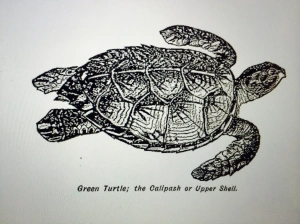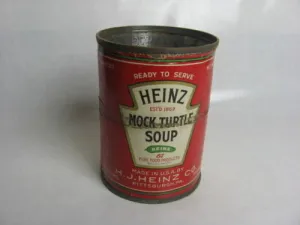“Neil, it’s your butcher, Lee.”
“Hi Lee, what can I do for you?”
“Did you by any chance order a calf’s head a couple of weeks ago? It’s the kind of thing you would order.”
“You’re right it is the sort of thing I’d order, but I didn’t, sorry.”
“Well someone did, but I can’t remember for the life of me who it was!”
“Oh dear. Well if you don’t find the culprit, let me know, I’m sure I can take it off your hands.”
And that’s how I became the owner of a calf’s head; and I knew exactly what I was going to make with it once it got my hands on it: the mysterious Victorian classic, Mock Turtle Soup.
Mock turtle soup was invented from necessity – turtle soup had become immensely popular in the 1750s after sailors coming from the West Indies landed a couple of them upon British soil. Sailors would catch them and keep them alive on their ships as a source of fresh meat. They were very delicious, and it’s a surprise that any even made it back. Those that did, were readily snapped up by royalty. Now everyone wanted to get their hands one and suddenly no banquet or dinner party was complete without its turtle soup. At its peak in trade, 15 000 live turtles were being shipped live from the West Indies per year. Of course, these huge beasts were very expensive, and because such numbers were being caught, trade was not sustainable and the green turtles were almost hunted to extinction, driving up price even further.
But why were they so popular? Obviously the royal family enjoying themgot the ball rolling, but their huge bodies were made up of different cuts of meat tasting of veal, beef, fish, ham and pork!
So real turtle soup quickly became out of the question for all but the super-rich, and so mock turtle soup was invented. Recipes vary in their ingredients containing beef, ham, oysters, vegetables, skin, tongue and brain in an attempt to replicate the diverse tastes and textures of turtle meat. One ingredient common to all of the recipes I’ve seen is calf’s head – an economical addition with plenty of tastes and textures in itself. Recipe-writers are quite particular about the fact that the head should have the skin on – the fat and skin adding to the texture and flavour of the dish. My head arrived skinned and it still tasted good. If your butcher sells veal, see if you can get hold of one. Mine cost a fiver!
Some recipes are very complex, but are essentially a consommé of meat served with the meat cut into chunks with various accompaniments such as forcemeat balls (or fish balls or egg balls), fried brains, oysters and fresh herbs.
Mock turtle soup became a British classic; Heinz even made and canned it! Alice in her trip to Wonderland met a real Mock-Turtle, depressed that he was no longer a real turtle. He was quite tiresome if I remember rightly.
Alice meets the Mock-Turtle
I adapted a recipe for an ‘old fashioned’ mock turtle soup from the 1845 book Modern Cookery for Private Families by Eliza Acton, then my chefs Harry and Matthew and I got to work on producing it as a special for the restaurant.
If you like the blogs and podcast I produce, please consider treating me to a virtual coffee or pint, or even a £3 monthly subscription: follow this post for more information.
To make mock turtle soup
As the butcher to split the head. As soon as you get home, remove the brain carefully and place in a bowl of well-salted water, cover with cling film and keep in the fridge until needed. You don’t need to include the brain if you don’t want to; it is tricky to prepare, but it is delicious. We didn’t use the brain as we took our time over a couple of days to make this in-between regular food service, and brain doesn’t really keep more than 24-hours. Because the head had already been frozen, we couldn’t re-freeze it either. If you don’t have the same issues as we did, get it cooked! There are brief instructions below on how to prepare brain, but for more detail, check out the sister blog here.
1 calf’s head with tongue, brain removed, split and soaked in salted water for several hours
4kg beef neck or shin
75g butter
1 smoked ham hock
4 large onions, quartered
3 large carrots, peeled and halved lengthways
2 heads of celery, quartered lengthways
Bouquet garni: rosemary, bay, thyme, pared rind of a lemon
1 dsp black peppercorns
Rinse the calf’s head and place in a large stockpot, cover well with tepid water and bring slowly to a bare simmer. Skim any scum that rises to the surface of the water, then cover with a lid and let the head cook for 90 minutes.
In the meantime, heat up the butter in a large frying pan and fry beef until well browned. Add this, along with the butter, to the pot with the ham hock, vegetables, bouquet garni and peppercorns. Turn the heat up a little and bring back to light simmer, letting the whole lot tick over for seven hours.
Carefully remove the larger pieces of meat and bone and strain the soup well. If need be, reduce the resulting broth to produce a more concentrated flavour. Discard the vegetables and herbs and carefully remove the meat from the bone. Skin the tongue and cut away any gristle and bone from the root end. The meat can then be either shred or cut into even-sized pieces.
To finish the soup:
Beurre manie of equal amounts of butter and flour mashed together to form a paste
200ml sherry
½ tsp ground mace
¼ tsp Cayenne pepper
Salt
Double cream (optional)
Forcemeat balls (see below)
Prepared brain (see further below)
Chopped parsley
As you prepare the meat, get the strained stock back onto a simmer. Whisk in knobs of beurre manie until the soup is as thick as you like, add the sherry and spices and season with salt. Return the meat to the pan. If you like, add cream to the soup.
Serve the soup in bowls topped with forcemeat balls fried in butter or lard, breadcrumbed brain slices and chopped parsley.
For the forcemeat balls:
300g streaky bacon, chopped
100g grated beef suet, fresh is best, but the packet stuff is fine too
75g fresh breadcrumbs
1 tbs chopped parsley
1 tsp chopped marjoram
2 eggs, beaten
Freshly grated nutmeg
Salt and pepper
Mix together the first six ingredients together in a bowl and season with the spices and salt. Roll into walnut sized pieces. Fry in butter or lard over a medium heat.
For the brain:
The brain, soaked in salted water for several hours in the fridge
Seasoned flour
1 egg beaten
Dried breadcrumbs
Sunflower oil or lard for frying
A brain is covered by a membrane of blood vessels which need removing. To do this, gingerly place the brain on a chopping board, with its underside facing upwards. Here the membrane is thickest, and is the easiest place to begin. Carefully pull the membrane away. This is quite tricky and takes a little practise. Ease your fingers between the folds and get as many of blood vessels pulled away.
Now poach the brain in salted water for about 6 minutes. Remove, drain and cool.
Cut the brain into thick slices, pulling away any bits of membrane you might have missed.
Set out three plates: one with flour, the other with beaten egg and the last with the breadcrumbs.
Coat the brain slices in flour, then egg, then breadcrumbs.
Heat up the oil or lard in a frying pan and fry the brain quickly until golden brown – don’t overcook! Fry for three minutes maximum.





![IMG-20160804-WA0002[1]](https://britishfoodhistory.com/wp-content/uploads/2016/08/img-20160804-wa00021.jpg?w=300)

Remember making this one when I was a student running regular Acton and Hartley dinner parties, back in the 60s. And very good it was. Used the pilot light to simmer everything overnight. (I was also working through Stella Atterbury.) Post BSE I think I’d skip the brains. (I don’t cook sheep’s head these days either.) I didn’t tell the dinner guests what the ingredients were – didn’t want the yuck factor to kick in in those unadventurous days. It went down very well.
Hope the restaurant is doing as well as it deserves to
LikeLike
Hi Kathryn – the restaurant is doing very well at the moment, as my bleary eyes show!
I think soups like this could be much more popular – this one’s maybe a bit rice for most, but those wholesome broths: cockie-leekie, cawl, etc are ripe for a comeback. I had cockie-leekie on the menu in the winter and it was a real hit. Seeing as i had to waer a coat this morning, you’d think it was November….perhaps I should get on it!
LikeLike
Hi,
I work for a production company currently making a documentary and wanted to inquire about using one of your images.
Do you have an email i can contact you on for more information?
Thanks very much
Amy
LikeLike
Hi. Yes my contact email is neil.buttery@yahoo.co.uk
LikeLike
Pingback: Mock pecan pie recipe – a baking challenge with a difference | My Custard Pie
Pingback: Suet – A Beginners’ Guide | British Food: A History
Pingback: The Fat Duck: the experience. – The Discerning Epicure
Pingback: Anyone for Mock Turtle soup? | Caron Allan Fiction
Pingback: Kaplumbağa Çorbası - Tarih ve Tarif
Pingback: Mystery in History – Amplifire Project
Pingback: DiscoverNet | Once Popular Comfort Foods No One Eats Anymore
this looks like a collagen rich soup 🙂
LikeLike
Haha – yes it certainly was! Wen it cooled down, you could sliced it up!
LikeLike
I have to ask, what did you do with the eyeballs? 👀
LikeLike
I don’t recall! But funnily enough, I just made a bonus episode of the podcast all about cooking and sourcing brains and eyes. They certainly were eaten by a few!
LikeLike
Eeeeeeww 🥴
LikeLike